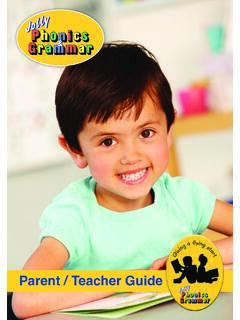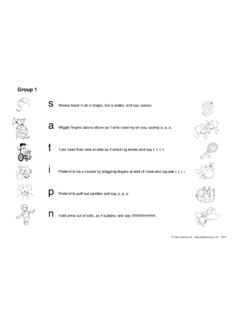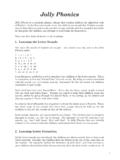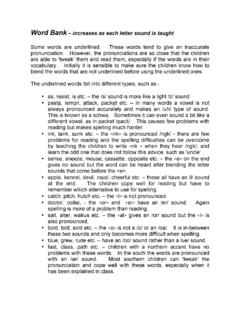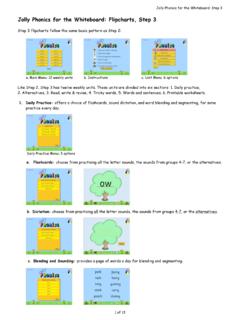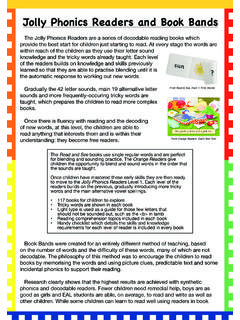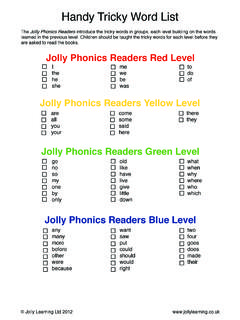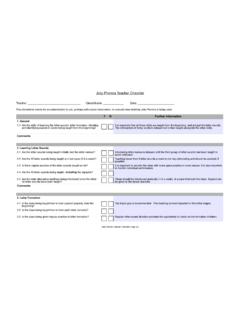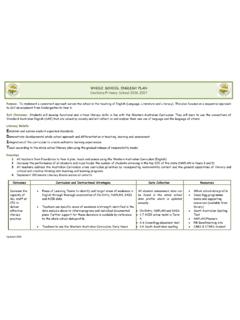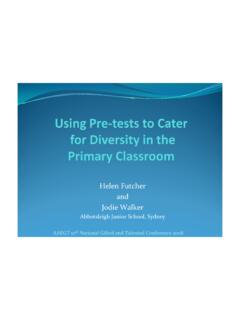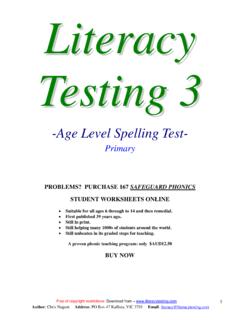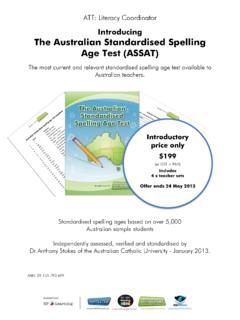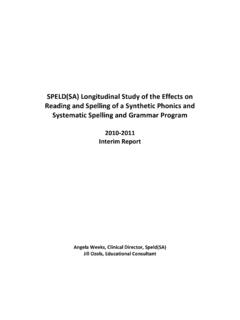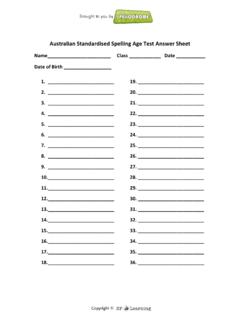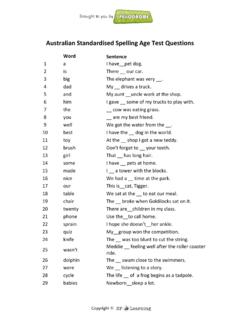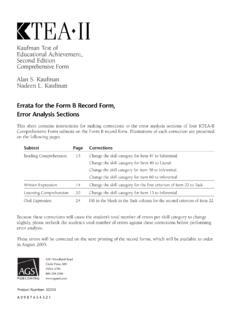Transcription of A4 Sydney Case Study G1 LATEST
1 Sh e s 5 , in her fi rst sch ool year, and Engli sh is her second what is her sc hool doing right?A Case StudyJessica wrote this:JessicaAt o ur school, w e have alwaysbe en concerned about thechi ld ren s li teracy s tandards. Wi thou r old phon ic s prog rammecombined with a whole languageapproach, thechil dren ha da goodknowledgeof the 26al phabet let tersan d s ounds by the end of theirki ndergarten year. But t heydid n t know ho w t o blend theseso unds for reading, or identifyth em in words fo r writing, andwe re unaw ar e o f sounds madewi th more th an one letter :dig raphs an d b Phonicste ac hes thes ethi ngs, and w e realised that th eprog ra mme had other advantagesfor our school community. Thech ild ren come from non-English-spea king backgrounds, and while asma ll percentage receive parentalsupport wi th their schoolwork, thevast ma jority rely o n the teacher astheir s ole educator.
2 The multi-sens or y approach of Jolly Phonicsso un de d ideal; teaching the 42so unds with actions and l ettersha pe s woul dreal ly he lp thechi ld ren learnand ing the pro gram me ..We attend ed an inservice onJolly Phonicsby author SueLloy d, and soon afterward sbeg an to tri al the programmewith our k indergar ten classes. Atfirs t we a dopted a flexibleapproach t o su it our school sspecial needs; we deci de d to in tr oducethe lettersounds ata slowe rra te thanThe PhonicsHandbooksug e ini ti al stag es ..We used ph on em ic awarenessacti viti es in the k ind er ga rt enpre-reading prog ramme to helpthe children identify the soundsin words. A fter a few weeks theywere alrea dy d oin g thi s bythem sel ves, ch oo sin g a word an dso unding it out with the actionsthe y had learnt.
3 The Jolly Phonicsmul tis ensor y approach mad ethe learning g reat fun for this fir st term, w e h ad onlyplan ned t o explo re on e newso und each week . H ow ever, eachlett er so und is intro duced with astor y, and we fou nd that thechil dren grew impati ent for mo resto rie s and ac tio ns, so informallywe b eg an to in troduce all theso unds. Duringsubseq uentterms t he p acewas increaseduntil eventuall ywe were teaching all 42 soundsin the firs t su gges ted by The PhonicsHandbook, t he chil dren tookhome a S ound boo k co nta in ingeach week s new so unds, and l at erWord B oxe s a nd li sts o f irregul ar or tricky wor ds. The childrenenjoyed this as th ey began toexperien ce the ir own re adi ngsuccess. Meanwhi le changeswere made to o ur rea dingpro gramme, tocom pl ementth e wholel a n g u a g ea p p r o a c hwith phonetics-based games and activities fromThe Phonics And th e suc ces sOver the course of the year wesaw how the children s con-fidence increas ed with thei runderstanding o f the 42 so the pho netics co mponentof our reading programme andJolly Phonicsas our phonicspro gramme, all the c hild ren we reabl e t o re ad a nd w ri te b y t he en d o fthe kindergar ten year.
4 Abilitylevel s v ar ied, b utthe st an da rd washigh . Jes sica swork (sh own o nfront cover) istypi cal of a fiv e-y e a r - o l d swri ting to wardsthe end of kind-ergarten, sincewe startedus in g hasus ed w ords wit h b oth sing le-l ett erso unds and dig rap hs, as well as a repertoire of tricky w ords thatcannot b e so un ded out. The hand writi ng styl e in JollyPhonicsdid not c onfuse thech ildren, w ho w ere be ing t augh tthe f ounda tion s tyl e s et b y t heNS W Dept . of Education. Wethought t his d iff erence i ns ignif-ic ant, s inc e c hildren are ex pose dto s o m any d ifferent st yl es of p rintin bo oks, s igns and th e ch ildr enbe ga n tosucceed inrea ding andwriting ve ryea rly in the irsch ooli ng an d t hey loved i t. T heywo uld of te n ask if th ey couldwr ite in spa re moment s!
5 Thissuc cess is ye t m ore a ston ishingwhe n o ne consi ders ho w many ofthe se c hildre n a re not givenpa re nt al support a nd speakEn gl ish on ly in school. We canonl y i magine t he s ucces s t hat JollyPhonicscould h ave in schoolswhere th e par ent al suppo rt ishigh a nd Engl ish i s th e c hildr en smai n l why arethe children so excitedabout it?Let Our La dy of Le ban on Sc hoo l*te ll you in their own *S ydney, Austral iaWhy we adopte d Jol ly Phonicsby Cel este Mu sgrav e & T ina Di Maur o, kindergarten te ac hersCelesteteaches the p sound the childrenpretend to puff outcandles, saying p! Tina s class learn the ie sound with itsaction they re pretending to be sailors andsaying Aye aye! The multisenso ryap proa ch was ide al for o urESL sch ool c om mun it y The children love d it th ey would ask to w ritein spa re moment s!
6 All th e ch ildre n co uldrea d an d w rit e b y the endof k inde rga rten I have been us ing The PhonicsHandbookfor tw o years n ow,foc ussing main ly on readin rough w eekly p honics lessons,I ha ve taught thech il dre n a ll thesounds of Eng-li sh in therec ommen de dor der, giving allof the spel li ngpo ssibili ties for e ac h sound. I nco mp ar ison with our o ld phonicsprog ra mmes, Jolly Phonicsgivesthe children more information ,significan tly extending their wordatt ack skill s. As a re sult, the iratt empt s to s ou nd out new wor dsare m ore e childre n s res ponse hasbeen very posit ive. T he y haveshown far more interest inreading th an in pre vio us years,and are more confident aboutreading new words. They oftendescribe al oud h ow they areta ck li ng unfamil iar wor ds, and Ican see that they are modellingstrategies f rom phonics lesso ns.
7 Wh en co nfronte d with a difficultword th ey remain po si tive, s im -ply label ling the word tricky and then moving on withoutfee li ng that they have fail ed. Thech il dre n are more po si tive evenwhen they make mistak ste ad of b ein g discouraged,the y are int erested in fin ding outhow th e word shoul d be readco rrectly. Phrases su ch as That sa to ugh word , or That ti me therul e d id n t work , really helped i nmain taining a positive atmos -phere and developing go od se lf-esteem in the childr en s readingand writing experiences. Ibelieve these positive feelingsto wards re ad in g are a di re ctresult of usingJolly Phonics. Initi all y, I w as anxio us aboutpr epar in g cl as sr oo m reso urcesfrom the repro du cible materialin The Phonics Handbook and itdid take ti me tomake all thebooks , flash-card s, bo ardgames, cha rts,etc.
8 Fo r thechildren s hands-on a cti vi ti es . With hindsight,th ough, I r eali se that theprep ara tio n was mor e thanwort hwhile , in creati ng funactivi tie s for t he chil dre n topractise their wo rd attack s kills. Iwas al so able t o us e manyex istin g cl ass ro om r esourc eswith only m ino r mo dificatio ns,and I had fun making u p gamesof my o my second year with Jolly Phonics, as well as beingbetter prepared in termsof resource s, I fe lt moreco nfi dent in my p ersonalunderstanding of theteaching principles. Imade a more det erminedef for t to e nc our age th echildren to use the wo rdattack skills they hadlear ned dur ing phonicsle sson s wheneve r theywere r ea ding and writingduri ng the nor mal s cho olda y.
9 So , in effe ct, pho ni csbe ca me a nat ural part ofdaily wor k, t aught for mal lyin spe cific time tabledlesson s and i nfor mallyth roughout everyday lear ning ac ros s the cur al res-ponse to theprogramme isvery posit ive. Par -en ts fr eque ntlyco mment on howmuch t hei r c hildr en enj oy r eadingan d onthe impro ve me nt s the yha ve n oti ced th emse lve s. So far I haveonl y us ed JollyPhonicsfortwo years but I feel sureI s hall continueto do so for a lo ng time to come!Result s of S ta nd ard is ed Rea ding and Sp ellin g Te st sKi nde rg art en Red (C eleste s class)Kindergarten Blue (Tina s class)Pupil:Boy/ActualReadingSpellingPup il:Boy/ActualReadingSpellingGirl:Age:Age :Age:Girl:Age:Age:Age:BHb5:46:76:2 FFb5:118:08:10 BNb5:116:16:3 INb6:08:49:3 CKg5:67:77:9 FSg5:106:78:10 CMb5:56:76:2 CDb6:25:76:2 DOb5:46:05:8 IBb5:55:36:0 DDb5:78:18:7 LDb5:106:1 NSFBb5:36:36:1 GEg5:45:76:2 FUg5:105:86:4 NNg5:85:96:7 GOg5:86:96:7 NBb6:17:07:3 HFg5:118:07:6 SNg5:76:76:2 HSg5:66:76:4 JKg5:46:07:5 HBg5:66:76:4 BNb5:67:98:7 HDb5:46:16:0 GKb5:36:06:3 IBb5:106:36:1 ONb5:76:26:4 ITg5:76:56:4 DFb5:35:86:6 ISb6:16:86:10 IKb5:116:66:11 INg5:37:26:6 OUb6:07:37:9 LDg5:96:76:11 DUg5:96:06:5 MCg6:26:46:4 OCg6:25:96:11 OSb5:97:28:3 MSg5:115:76:2 SAg5:86:56:4 NKb5:65:86:4 TFg6:25:96:5 KMg5:76:46:5 TBb6:07:88:0 NBb6:17:37:9 UTg5:46:46:1 NKb5:66:16:1 UDg5:116:86:4 GKg5:96:36:5 AHg6:07:08:3 HNg6:26:06:7 ANb6:27:48:3 HFb5:65.
10 86:5 OTg5:46:66:8 ARb5:115:26:8 Average:5:86:86:9 Average:5:96:36:11 Boys:5:96:96:11 Boys:5:96:57:2 Girls:5:86:76:7 Girls:5:86:16:8% above Actual above Actual Test : Da niels and Diack Standard Test of Reading SkillsSp ell in g T est : The south australian spelling Test (NS, or no score, considered a s )All ages shown in y ears and months. The chil dre nremain pos it iv e evenwhe n confronted with dif ficu lt word s Usi ng Jolly Phonic sby J uli e Fi guero , Year 1 thechildren were aheadin reading and ahead inspelling! P ar ents oft en say theynotice ch ildre n s re adin ghas im pro ved As princ ipal, I encourage thestaff to expl ore an dim ple ment changes which maybenefit the children s learni ng .Due to ou r non-Eng li sh-speak-in g school community, thechi ldren s l evel o f lit eracy hasoft en been a conc ern. When twoof my kinder ga rt en te achersappr oached me, I we lc om edtheir su gg estion that we try anew pho ni cs progra mme,pr ovi ded that a trial pe rio dpro ved it to be beneficial.
